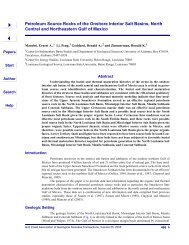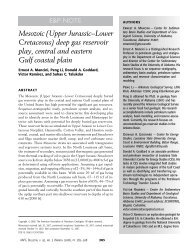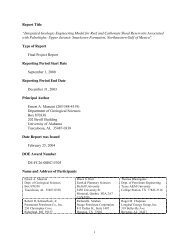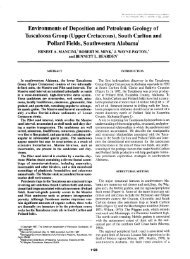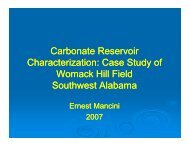Part 4 - Berg - Hughes Center
Part 4 - Berg - Hughes Center
Part 4 - Berg - Hughes Center
Create successful ePaper yourself
Turn your PDF publications into a flip-book with our unique Google optimized e-Paper software.
gray shale. In southern North Louisiana and East Texas, it is characterized by porous,<br />
oolitic, and fossiliferous or fossiliferous-fragmental limestone.<br />
Hermann (1976) described the James as reef-like deposits within an arcuate trend in<br />
Winn and Natchitoches Parishes, Louisiana. His description of the James is as follows:<br />
The principal limestone varieties within this trend are light-colored, pelletal-miliolid<br />
calcarenite, pelletal calcarenite, pelmicrite, and caprinid biosparite. On well logs the<br />
limestone is characterized by a leftward excursion of the spontaneous-potential curve<br />
giving the zone the massive look of a reef section as much as 300 ft (91 m) thick in one<br />
test well. However, the limestone appears to be nonreef in origin. Isopach studies have<br />
shown that the James is a detrital deposit that accumulated in low areas. The trend<br />
probably contains local patch-reef developments as indicated by the presence of a few<br />
caprinid zones, but it does not appear to be a true reef trend as generally defined.<br />
Southwest, south, and east of the main trend the James consists principally of interbedded<br />
gray argillaceous micrite and gray shale, and on the north and northwest it consists of<br />
some combination of interbedded gray micrite, oomicrite, oosparite, quartz sandstone,<br />
and gray shale.<br />
The James Limestone produces from numerous fields from east Texas, through<br />
Louisiana to southern Mississippi. Production is mainly from rudist-coral-stromatoporoid<br />
reef facies on salt-related structural highs in the interior salt basins of east Texas, north<br />
Louisiana (Chatham field), and Mississippi (Hermann, 1976). When Chatham field was<br />
discovered in 1960, original estimates were 400 million bbl oil in place, of which at least<br />
230 million bbl are recoverable. The few test wells that have cored the James massive-<br />
limestone interval indicate that porosity ranges from 10 to 15%, but is generally less than<br />
369




